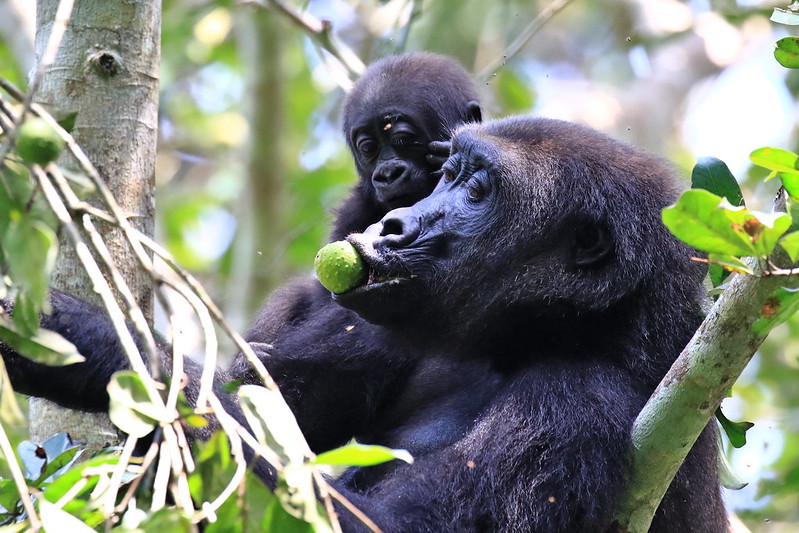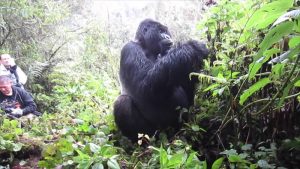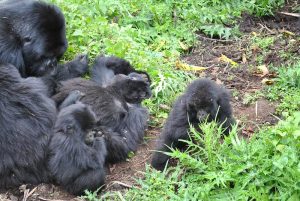how do gorillas adapt to the environment?
In the dense rainforests of Central Africa, a remarkable species reigns supreme—the mountain gorilla. These gentle giants have evolved over centuries, developing unique adaptations that allow them to thrive in their natural habitat. Abunda Discoveries Uganda invites you to delve into the fascinating world of gorilla adaptation, exploring the ways in which these incredible primates have mastered the art of survival in the lush and challenging environments they call home.
Bipedal Locomotion:
Gorillas exhibit a form of bipedal locomotion, meaning they can walk on two legs. While not their primary mode of movement, this adaptation allows them to cover short distances upright, freeing their hands to carry food or navigate uneven terrain.
Specialized Hands and Feet:
Gorillas have hands and feet adapted for different functions. Their hands boast opposable thumbs and strong gripping capabilities, aiding in the manipulation of objects and the consumption of a variety of plant foods. Meanwhile, their feet are designed for stability and support during both ground and tree-based activities.
Dentition for Herbivorous Diets:
The dentition of gorillas is well-suited for herbivorous diets. Their large molars and premolars facilitate the grinding of fibrous plant materials, such as leaves, stems, and bark, which constitute the majority of their diet.
Powerful Physique:
Gorillas possess a robust and muscular physique, adapted for both terrestrial and arboreal activities. Their powerful arms and shoulders are well-suited for climbing and swinging through trees, while their large, strong bodies provide the strength needed for ground locomotion.
Long, Strong Arms:
Gorillas have disproportionately long and strong arms compared to their legs. This adaptation aids in brachiation (swinging from branch to branch) and allows them to efficiently move through the dense vegetation of their forest habitats.
Nuchal Crest for Jaw Muscle Attachment:
The nuchal crest, a ridge on the back of a gorilla’s skull, serves as an attachment point for powerful jaw muscles. This adaptation supports the gorilla’s herbivorous diet, facilitating the consumption of tough plant materials.
Social Structure and Communication:
Gorillas exhibit a complex social structure within their groups, which typically consist of a dominant silverback, females, and their offspring. This social adaptation helps them navigate their environment effectively, share resources, and provide protection against potential threats.
Nest Building for Shelter:
Gorillas construct nests for resting and sleeping, usually in trees for added safety. This adaptation allows them to navigate the challenges of the forest floor, where they may face threats from predators, and provides a comfortable and secure place for rest.
Communication through Vocalizations:
Gorillas communicate through a variety of vocalizations, including grunts, roars, and hoots. This adaptation aids in social bonding, territory delineation, and the coordination of group activities, ensuring effective communication within their complex social structures.
Thick Fur for Thermal Regulation:
The dense fur of gorillas serves as an adaptation for thermal regulation. In the cool and often wet environments of their habitats, this fur provides insulation, helping them maintain a stable body temperature.
Nomadic Lifestyle:
Gorillas exhibit a semi-nomadic lifestyle, moving through their home ranges in search of food resources. This adaptation allows them to efficiently exploit the varied vegetation available, preventing overexploitation of any particular area.
Emotional Intelligence:
Gorillas display remarkable emotional intelligence, forming strong bonds within their social groups. This adaptation fosters cooperation, caregiving, and mutual protection, contributing to the overall well-being and survival of the group.
Conclusion:
Gorillas, with their intricate adaptations, exemplify nature’s ability to craft creatures perfectly suited to their environments. Abunda Discoveries Uganda celebrates the resilience and sophistication of these magnificent primates, inviting you to witness their extraordinary adaptations during a gorilla trekking experience in the heart of Africa’s captivating rainforests. As you explore the gorillas’ natural habitats, you gain a deeper appreciation for the intricate web of adaptations that allows them to flourish in the wild, showcasing the delicate balance of nature’s design.




